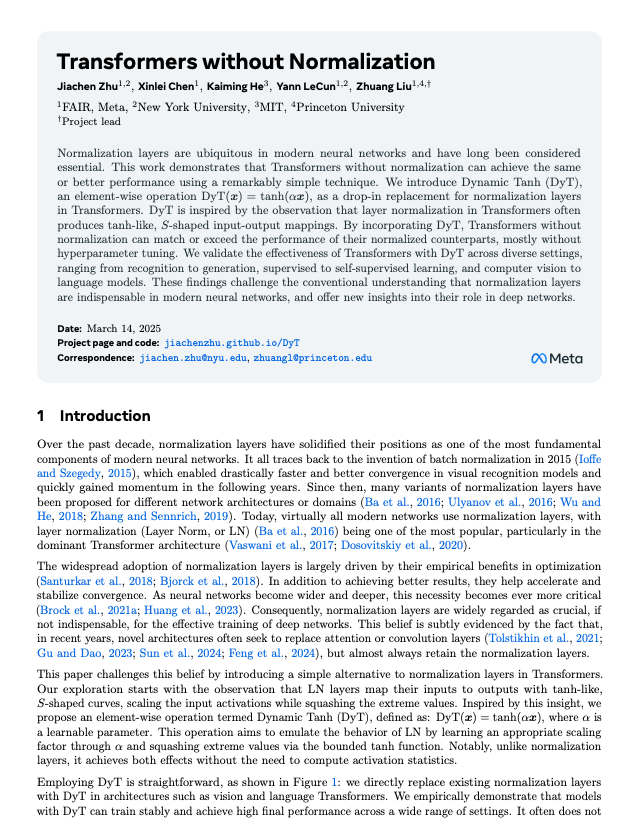A Major Architecture Change in AI
It used to be so normal to normalize...
As if things weren’t moving fast enough already… now we are reconsidering a major part of neural network architecture that has MAJOR implications for the future of AI.
This research paper challenges the long-held belief that normalization layers are essential components in modern neural networks, particularly within the Transformer architecture.
The authors, highly gifted nerds at META, introduce a remarkably simple technique called Dynamic Tanh (DyT) as a drop-in replacement for normalization layers like Layer Norm (LN) and RMSNorm. DyT is an element-wise operation defined as DyT(x)=tanh(αx), where α is a learnable parameter. This approach is inspired by the observation that normalization layers in Transformers often produce tanh-like, S-shaped input-output mappings, scaling input activations and squashing extreme values.
Transformers without Normalization empirically demonstrates that Transformers incorporating DyT can achieve performance comparable to or even better than their normalized counterparts across a wide range of tasks and domains. These include supervised learning in vision (ImageNet classification with ViT and ConvNeXt), self-supervised learning in vision (MAE and DINO), diffusion models (DiT for image generation), large language models (LLAMA pretraining), self-supervised learning in speech (wav2vec 2.0), and DNA sequence modeling (HyenaDNA and Caduceus). Notably, these performance levels are often achieved without significant hyperparameter tuning.
The authors further analyze the behavior of normalization layers, revealing that deeper LN layers exhibit tanh-like input-output relationships. DyT aims to replicate this behavior with a learnable scaling factor (α) and the bounded tanh function, without needing to compute activation statistics like mean and variance. Preliminary results also suggest that DyT can improve training and inference speed. This research challenges the necessity of normalization layers in deep networks and offers new insights into their role.
We will discuss the implications of this in a moment, first we need to nail down what’s happening here using my favorite tool: analogy.
Super Simple Analogy:
Imagine a group of runners (activations) in a race.
Normalization: Normalization is like forcing all the runners to start at the same point on the track and then adjusting their speeds so that the average speed and the spread of speeds are consistent across different races (training iterations). This prevents any one runner from being too far ahead or too far behind, making the race (training) more stable. This involves calculating the average position and spread (mean and variance) of all runners.
DyT: DyT is like giving each runner a special pair of "smart shoes." These shoes have a built-in mechanism that automatically slows down a runner if they get too fast (extreme activations) and keeps them moving at a reasonable pace if they're moving at a normal speed. The "smartness" of the shoes is controlled by a single dial (the 'α' parameter) that can be adjusted. Crucially, each runner's shoes operate independently – they don't need to know anything about the other runners.
Normalization is a global operation, coordinating all runners. DyT is a local operation, acting on each runner individually. The "squashing" effect of the smart shoes (tanh) mimics the effect of normalization in keeping the runners within a reasonable range.


